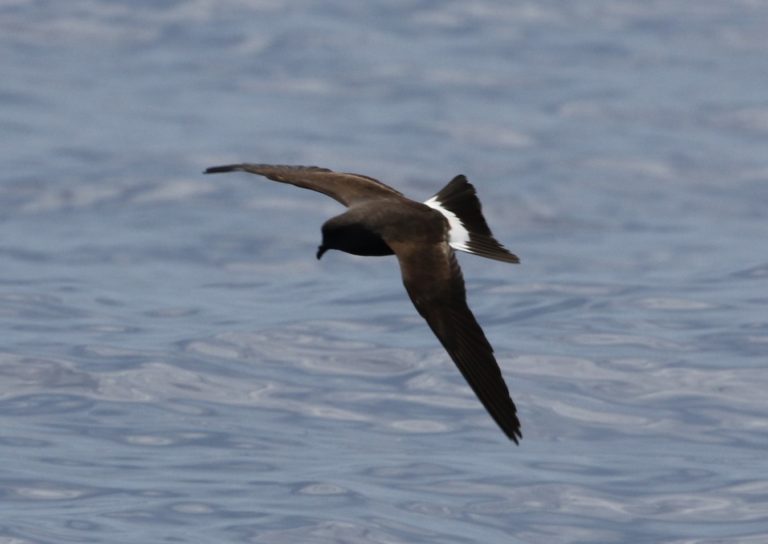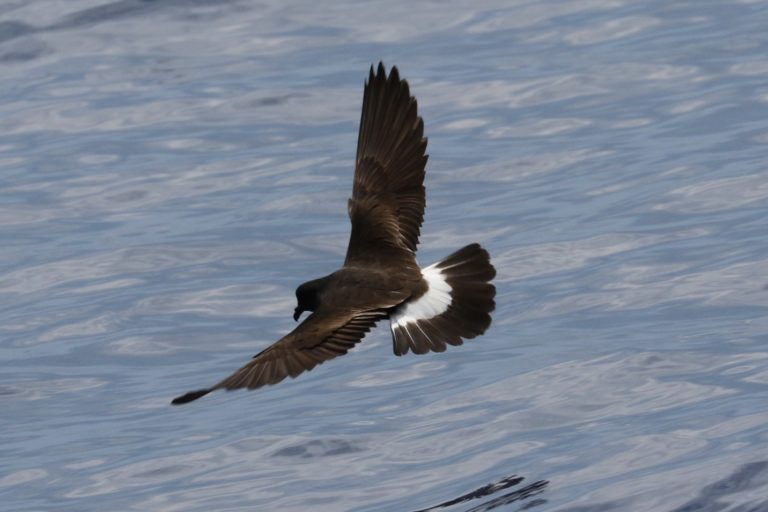Hydrobatidae: Northern Storm-Petrels
Storm-petrels are thrush-sized seabirds that rarely approach land except to nest, and usually at night, so most people never see them. They spend most of their time over deep oceanic waters inconspicuously flitting around their larger and better-known relatives, such as albatrosses and shearwaters. Storm-petrels comprise two of the four families known as “tubenoses”—named for the tubular nostril-like structures on the tops of their bills which apparently provide two functions crucial to their maritime lifestyles: secreting excess ocean salt and enabling the birds to detect subtle scents and follow them to ephemerally productive foraging areas scattered far and wide across the open ocean.
All storm-petrels are roughly the same size and shape, and all were traditionally regarded as belonging to a single family, which seemed to be the only conceivable approach to classifying this outwardly uniform group. Advances in genetic analytical methods fundamentally changed this understanding, however, revealing that the northern- and southern-breeding species are not closely related, so they are now classified as two families: the Hydrobatidae (northern) and the Oceanitidae (southern). One interpretation of the DNA evidence concludes that the southern storm-petrels were the first lineage of tubenoses to diverge from the rest and are more closely related to albatrosses than to the northern storm-petrels—but this remains unsettled.
Identification
Northern storm-petrels are among the most challenging birds to identify. They are difficult to find, difficult to observe, and difficult to hear. Several species, though distantly related, have nearly identical plumages. Within these visually confusing groups, structural and behavioral differences—especially flight patterns—tend to be the most readily observable and reliable basis for identification in the field.
The recognition of “cryptic species” complexes within the Hydrobatidae scrambles the traditional assumptions and elevates the identification challenge from difficult to impossible—as the concept of cryptic species is equivalent to stating that two or more populations are separate species but are not distinguishable under most conditions. To identify birds in these groups, geographical probability tends to be the decisive factor. However, deepening the confusion, some of the recently described cryptic species complexes in the Hydrobatidae have widely overlapping ranges, which limits the value of geographical probability.
One species, Leach’s Storm-Petrel (Hydrobates leucorhous), presents a unique challenge as it varies so widely in appearance that it is easily mistaken for most other species in the Hydrobatidae, including multiple sets of cryptic species. Moreover, Leach’s is nearly global in distribution and overlaps with all of the other species in the family.
Taxonomy
The species-level classification of the Hydrobatidae was long regarded as stable, but it has become deeply unsettled with the recognition of cryptic species complexes and resulting uncertainty about where to redraw the lines. Relationships among the distinguishable species are also unsettled, as genetic analyses have produced inconsistent conclusions about which lineages diverged earliest and which species are closely related enough to be grouped in one genus or another. Recent attempts to reorder the family according to its true evolutionary branches and apply the nomenclatural conventions of taxonomy have used up to six generic names: Hydrobates, Oceanodroma, Thalobata (or Thalobates), Halocyptena, and Cymochorea. In the continuing uncertainty, however, the favored approach has been to provisionally use Hydrobates for all species clusters until the underlying relationships are clarified.
Among the most cryptic and complex of all cryptic species complexes yet discovered in any bird family is that of the Band-rumped Storm-Petrel (H. castro). What was long regarded as a single species (and monotypic—i.e., lacking enough variation to be divided into subspecies) that bred in various far-flung archipelagos of the Atlantic and Pacific is undergoing a subdivision into anywhere from three to nine species. The North Atlantic populations include at least three deep genetic divergences that have been corroborated by voice response studies, resulting in the recognition of Cape Verde Storm-Petrel (H. jabejabe) and Monteiro’s Storm-Petrel (H. monteiroi). Attempts to systematize the South Atlantic and Pacific populations have been less conclusive, but thus far indicate that these groups contain multiple comparably distinct lineages and generally do not respond to voice recordings from the North Atlantic. Based on the indications available so far (in late 2021), a likely subdivision of the remaining H. castro populations appears to be: two species in the Pacific and two or three species in the Atlantic.
What was traditionally known only as Leach’s Storm-Petrel (H. leucorhous) now appears to comprise three or four cryptic species, and two more potential cryptic species pairs seem well-supported by evidence, but remain under review: Wedge-rumped Storm-Petrel (H. tethys) and European Storm-Petrel (H. pelagicus).
The resulting count of northern storm-petrels rests somewhere in the span of 18 to 27 species (plus one recently extinct).
Cape Verde Storm-Petrel (Hydrobates jabejabe)
Monteiro’s Storm-Petrel (Hydrobates monteiroi)
Band-rumped Storm-Petrel (Hydrobates castro)
“Grant’s Storm-Petrel” (H. c. ssp. nova)
“Madeiran Storm-Petrel” (H. c. castro)
“Gulf of Guinea Storm-Petrel” (H. c. ssp. nova)
“St. Helena Storm-Petrel” (H. c. helena)
“Japanese Storm-Petrel” (H. c. kumagai)
“Hawaiian Storm-Petrel” (H. c. cryptoleucurus)
“Darwin’s Storm-Petrel” (H. c. bangsi)
Fork-tailed Storm-Petrel (Hydrobates furcatus)
European Storm-Petrel (Hydrobates pelagicus)
“British Storm-Petrel” (H. p. pelagicus)
“Mediterranean Storm-Petrel” (H. p. melitensis)
Ringed Storm-Petrel (Hydrobates hornbyi)
Least Storm-Petrel (Hydrobates microsoma)
Wedge-rumped Storm-Petrel (Hydrobates tethys)
“Galápagos Storm-Petrel” (H. t. tethys)
“Peruvian Storm-Petrel” (H. t. kelsalli)
Black Storm-Petrel (Hydrobates melania)
Markham’s Storm-Petrel (Hydrobates markhami)
Matsudaira’s Storm-Petrel (Hydrobates matsudairae)
Tristram’s Storm-Petrel (Hydrobates tristrami)
Swinhoe’s Storm-Petrel (Hydrobates monorhis)
Ashy Storm-Petrel (Hydrobates homochroa)
Guadalupe Storm-Petrel (Hydrobates macrodactylus) †
Townsend’s Storm-Petrel (Hydrobates socorroensis)
Ainley’s Storm-Petrel (Hydrobates cheimomnestes)
Leach’s Storm-Petrel (Hydrobates leucorhous)
“Leach’s Storm-Petrel” (H. l. leucorhous)
References
Boyd, J.H., 2019. Taxonomy in Flux: Mirandornithes & Ardeae I. http://jboyd.net/Taxo/List8.html#procellariiformes. (Posted December 15, 2016; Accessed July 30, 2020.)
Brooke, M. 2004. Albatrosses and Petrels across the World. Oxford University Press.
Howell, S.N.G. 2012. Petrels, Albatrosses & Storm-Petrels of North America. Princeton University Press, Princeton, N.J.
Howell, S.N.G., and K. Zufelt. 2019. Oceanic Birds of the World. Princeton University Press.
Hume, J.P. 2017. Extinct Birds (Second Edition). Bloomsbury Publishing PLC, London.
Onley, D., and P. Scofield. 2007. Albatrosses, Petrels & Shearwaters of the World. Princeton University Press, Princeton, N.J.
Prum, R.O., J.S. Berv, A. Dornburg, D.J. Field, J.P. Townsend, E.M. Lemmon, and A.R. Lemmon. 2015. A comprehensive phylogeny of birds (Aves) using targeted next-generation DNA sequencing. Nature 526:569-573.
Roberson, D. 2016. Bird Families of the World: Northern Storm-Petrels, Hydrobatidae, http://creagrus.home.montereybay.com/storm-petrels.html. (Posted January 29, 2016. Accessed July 30, 2020.)
Text © Russell Fraker / December 16, 2021

